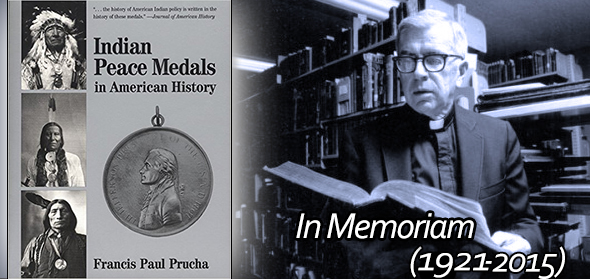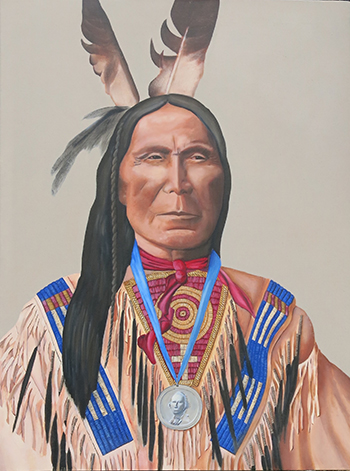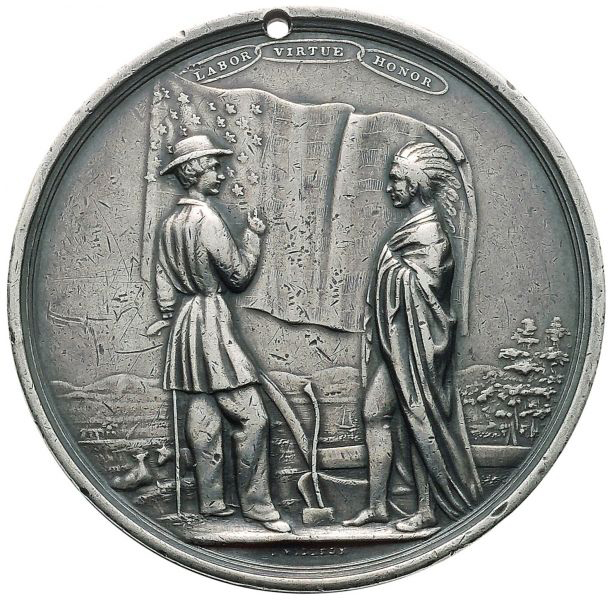
By Pete Smith for CoinWeek.com….
Francis Paul Prucha, author of Indian Peace Medals in American History, died on July 30, 2015, at age 94. His book, published in 1971 by University of Nebraska Press, has become the standard reference on the topic.
Prucha was born in River Falls, Wisconsin, on January 4, 1921. He received a Bachelor of Science from Wisconsin State Teachers College at River Falls in 1941 before service in the United States Army Air Force during World War II. He returned to study at the University of Minnesota earning his M. A. in 1947, then went on to Harvard and received a Ph.D. in 1950.
He joined the Jesuit Society of Jesus in 1950 and studied at Saint Louis University and Saint Mary’s College. He was ordained in 1957 and began teaching at Marquette in 1957. He continued to teach history there for fifty years.
Prucha was a student and teacher of western history and U. S. Indian policy. He conducted a study funded by a Guggenheim Fellowship. This resulted in his two-volume book, The Great Father: The United States Government and the American Indians, published in 1984. Over the course of his career, he wrote about 25 books on related topics.
On the occasion of Prucha’s 90th birthday, a colleague, Professor Phil Naylor, commented on his sense of humor: “We are not talking about a dry wit, but one which is Saharian in its aridity.”
In his reference, Prucha says very little about the origins of Indian Peace Medals and their use by the British, French and Spanish during colonization and during the French and Indian Wars. Early gifts to the Indians were unofficial and non-standardized. Later the official medals became very important symbols in the negotiation of treaties and sealing of alliances during the colonial period.

In 1677 an engraved medal was presented to Cockacoeske, the Queen of the Pamunkey for the signing of a treaty for the Virginia Middle Plantation. This was a frontlet that does not look like the hanging medals that have become familiar.
The collection of Indian Peace medals of John J. Ford was conducted by Stacks on October 17, 2006, as Part XVI of the Ford sales. The catalog, written primarily by Michael Hodder, is an excellent source of supplementary information to the Prucha book.
A subtitle of the catalog, “Medallic Distinctions Awarded to First Peoples,” suggests that all pieces in the collection were awarded. This is far from the truth; many of the early medals in the sale are “conjectured” to be Indian medals with little proof. The catalog reports that the medals of George I issued around 1714-27 are the first that can be verified from grave finds as actually presented to Indians.
While medals found in grave sites may have provenance as pieces actually awarded, these are problematical. What was once acceptable may now be considered looting and historical societies are wrestling over the proper display of such looted treasures and requests from Native Americans to return them to the tribes for respectful reburials.
Thirty British Indian Piece medals were shipped to New York in 1753 (Betts 396). They were ordered by the Governor of New York, Sir Danvers Osborn, for presentation to chiefs of the Six Nations. These featured an obverse of George II facing left and the Royal Arms on the reverse.
In 1757 the first Indian Peace Medals were produced in America with an obverse of George II (Betts 401). The dies were cut by Edward Duffield in Philadelphia and pieces were struck by Joseph Richardson for the “Friendly Association for Regaining and Preserving Peace with the Indians by Pacific Means.” These are known as the “Quaker” or Treaty of Easton medals.
Medals issued for George III and dated 1762 (Betts 438) were exchanged for French medals. The French had not issued medals specifically for presentation to the Indians. Rather medals produced for other purposes were repurposed for presentation.
The Ford collection included only a single medal attributed to the Spanish and was a Charles IV medal dated 1806. This was struck at the Mexico City Mint. These medals represent Mexican influence in the Southwest states rather than Spanish colonial influence prior to the American Revolution.
The native peoples west of the United States were familiar with peace medals distributed by the British, French and Spanish during colonization. With the western expansion of the United States, it became essential to replace these medals with American medals to seal agreements with the Indians.
When Lewis and Clark made their expedition up the Missouri River in 1804-06, they carried 32 such medals. These were the Jefferson medals made from obverse and reverse shells joined with a silver rim in three sizes with the largest more than four inches in diameter. The Corps of Discovery was not just for exploration, but also to carry word to the Indians that the Great Father in Washington would now be responsible for their lands and their welfare.

The book covers Indian peace medals from the engraved pieces of President Washington to the shell medals for President Jefferson and the Mint struck round medals of President James Madison through President Grant to the oval pieces of Hayes, Garfield and Arthur and finally to the round pieces of Benjamin Harrison.
Four hundred years after the discovery of America by Columbus, and by the time of the Columbian Exposition of 1892-93, these medals produced by the Mint had been presented for the last time to Indian chiefs.
Copies of Indian medals have been made by the Mint from the 1860’s until the present day. With original pieces very rare and restrikes very common, most pieces seen in the market will be from the various restrikes.
Some collectors follow the guidance to “Buy the book before the coin.” I do not own an Indian Peace Medal and do not aspire to own one. I bought the book from my interest in numismatics and of Indian history.
While the book might inspire others to collect Indian Peace Medals, I was inspired in a very different way. I was inspired to paint a portrait of one of the chiefs wearing an Indian Peace medal.
Page 69 shows a black and white photograph of Yellow Hair, a Brule Sioux chief. He is wearing an Indian Peace medal with the portrait of President Washington. These are dated 1789 but probably produced a hundred years later. They were not officially authorized or produced but were widely distributed.
The photo was taken about 1904. The historical accuracy of such studio photographs may be subject to question. In some cases, costume accessories were provided by the photographer.
Yellow Hair is seen in an earlier photograph wearing the same shirt. The Washington Indian Peace medal is seen on only the second photograph. It is possible this medal was used with portraits of other Indians taken about the same time.
I was inspired to interpret this black and white photo into an oil portrait of Yellow Hair in color. I did not record the date but this was more than thirty years ago. It is painted on canvas 24 by 32 inches in size. The painting was displayed occasionally in my apartment but was probably seen by fewer than a dozen people. I am offering a view now for the first time to a broader audience.




